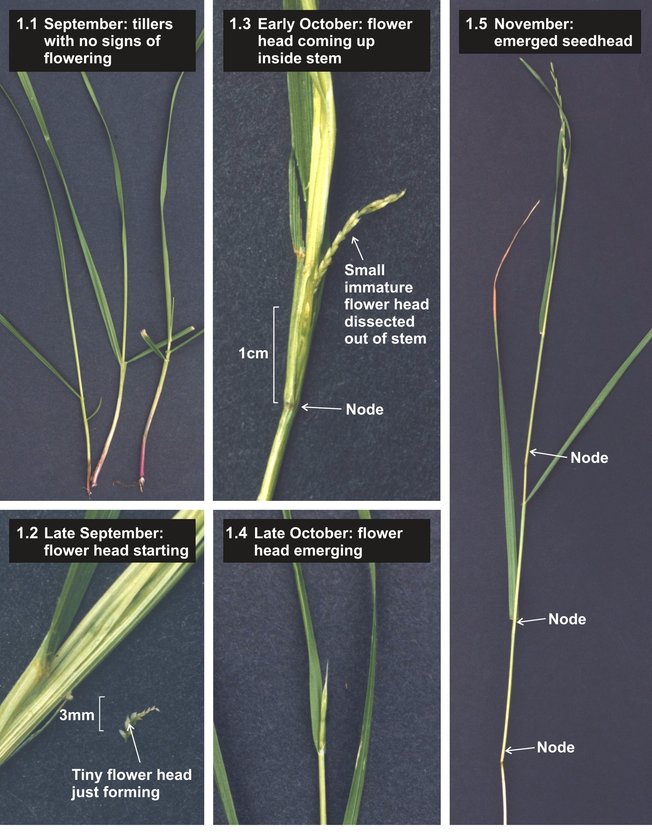Managing dairy pastures through ryegrass heading (late Oct - Dec)
Take home messages
- Ryegrass heading (or flowering) in the next 6-8 weeks means:
- higher pasture growth rates,
- decreasing quality, and;
- rapid changes on your farm.
- Limiting seedheads and loss of quality can give an extra 100kgMS/ha, worth $460/ha at little additional cost!
- Monitor covers, post grazing residuals, make silage early and use N.
Grass is a wonderful thing, except at the end of October when it goes to seed!
So why do we get it wrong? What happens is pretty predictable, right? Well, the trouble is pasture growth rates are at their highest, and quality is decreasing, so changes happen quickly. We need to put steps in place to make sure things stay on track.
What happens in pastures through October - November?
Our pastures fundamentally change in early October, as ryegrass initiates flowering, and a flower head (or seedhead) starts forming in the base (figure 1.2).
Presently ryegrass stems are elongating, with nodes (or lumps) appearing on them. The flower head is about 1cm above the top node (figure 1.3). The stems continue to lengthen and flower heads finally appear (figure 1.4) in early heading cultivars in late October.
Can you stop flower heads in early October?
Not completely, but you can limit them with good even grazings. When ryegrass stems are elongating and nodes appear, grazing to the level of the node (as in figure 1.3 for instance) kills the seedhead. The tiller then grows again from the base, usually changing back to leafy vegetative growth.
Green flowering stems are nearly as digestible as leaf, and are eaten by cows with little if any reduction in milk production.
How does ME change?
Limiting seeding can maintain pasture at 0.5ME higher, which gives an extra 7.7kgMS per tonne pasture harvested. If you harvest 13tDM/ha of pasture this is an extra 100kgMS/ha, worth $460/ha income at the current payout.
Figure 1. Ryegrass flowering or seedhead development
(times are for an early heading cultivar, add 2-3 weeks for a late heading cultivar).
What 3 things should you do in late October - December?
- Monitor cover - and identify & act on surpluses early
The difference between monitoring and producing a weekly feed wedge or not, is the wedge can predict or show a surplus 2-3 weeks before you actually “see” it.
Act quickly when you have identified a pasture surplus. For example, skip longer paddock(s) and get them made into silage. Light crops are good, as they allow flexibility – they are quickly back into the grazing round in case conditions change (e.g. things go dry). They also make the best quality silage.
- Check post grazing residual
For pasture quality, one of the most important people is the one that gets the cows! They get to see if the job is being done right through late October - December.
If you get the post-grazing residual right, and nip off many seedheads before they emerge (see Figure 1.3), you will get leafy regrowth for the next grazing.
Graze at the right height before the pasture loses quality at the base. If it’s high ME feed, and your stocking rate is right, the cows will graze to the right residual and milk well.
A mower can be a useful tool to reset quality.
- Nitrogen
Nitrogen fertiliser (e.g. 30kg N/ha) can be useful to give a boost to ryegrass plants through late November into December, to help them re-tiller prior to summer.
Conclusions
- Ryegrass heading means high pasture growth rates, decreasing quality, and rapid changes in pasture on your farm.
- Limiting ryegrass seedheads and loss of quality could give an extra 100kgMS/ha.
- Monitor pasture cover, post grazing residuals and use N.


